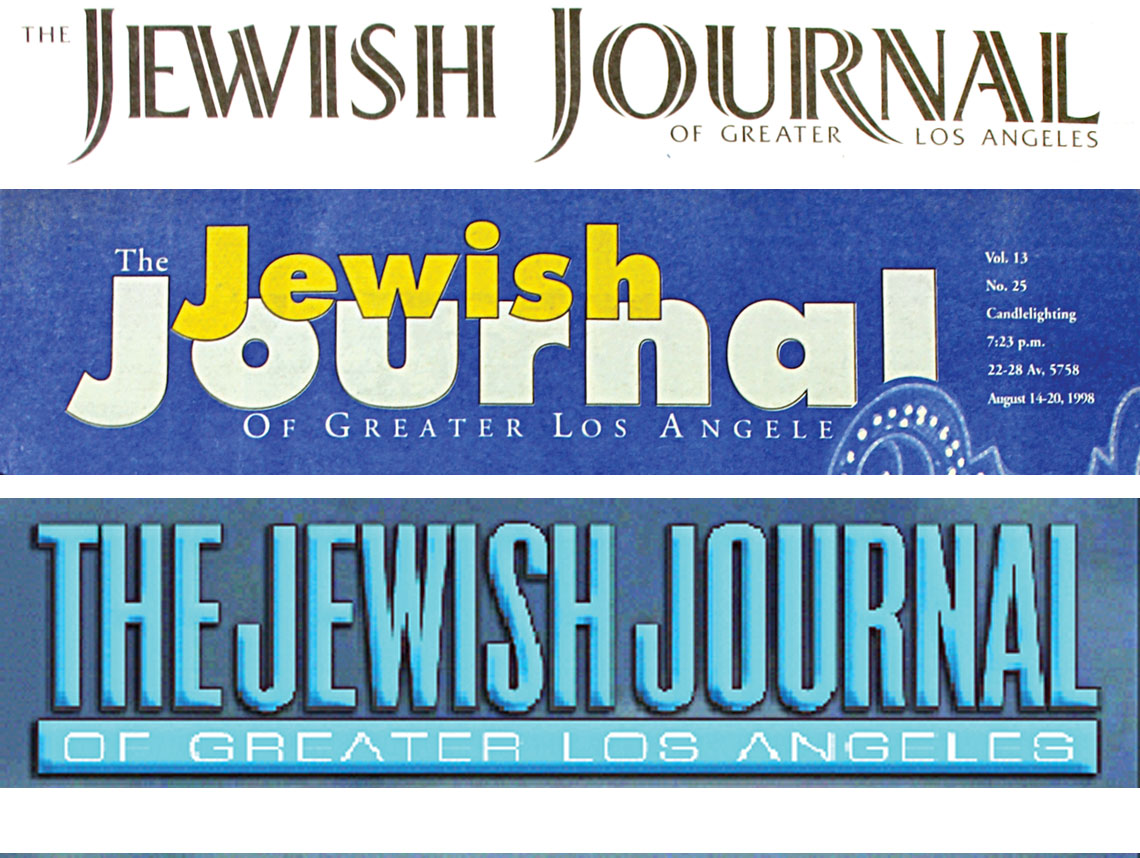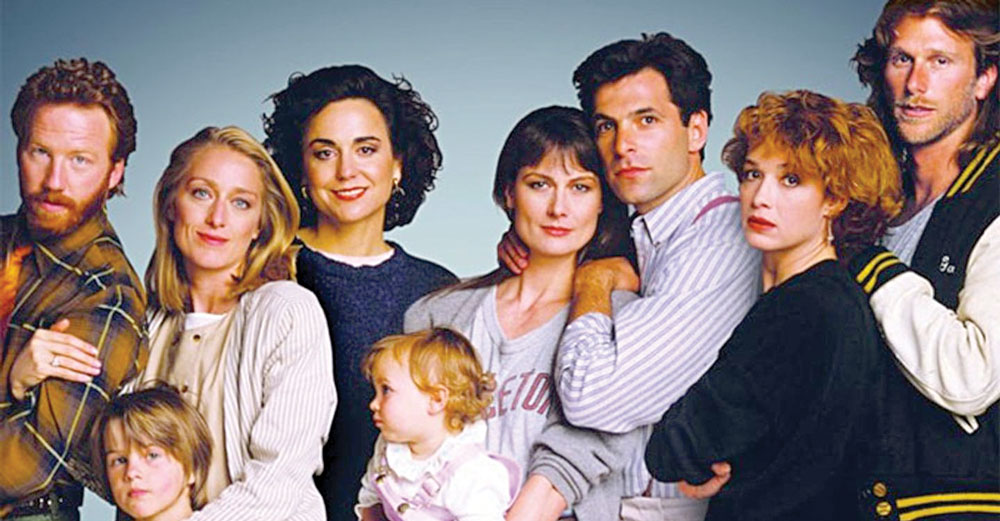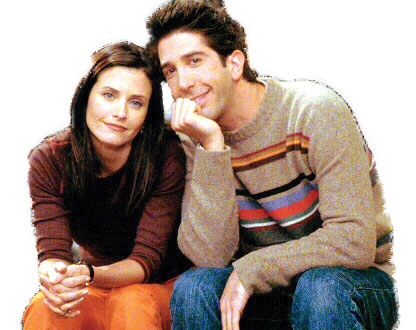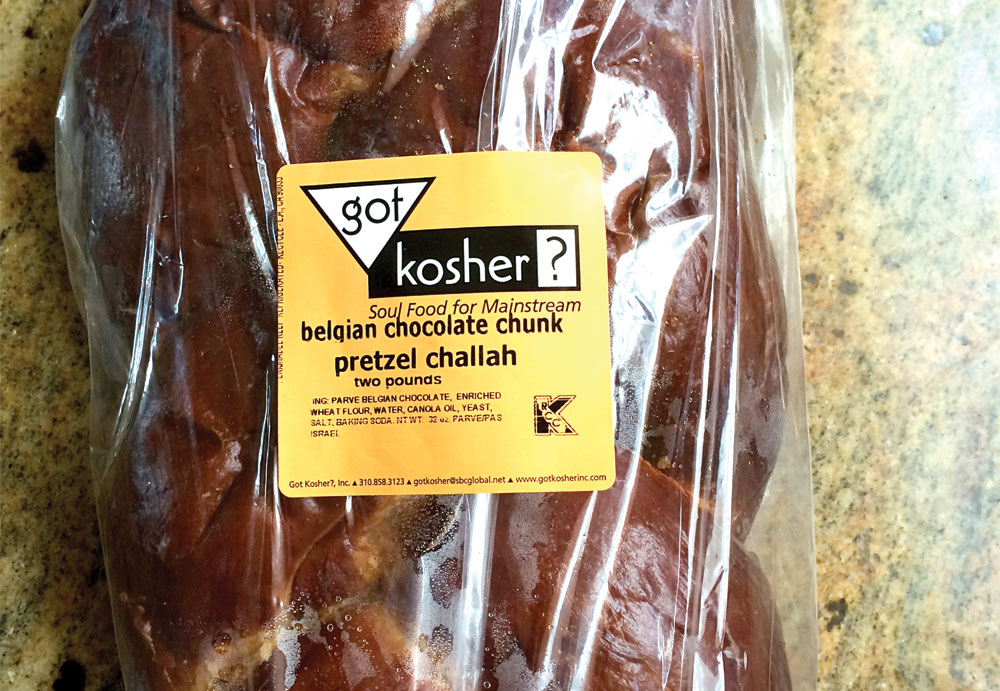
In the Jewish Journal’s inaugural issue on Feb. 28, 1986, readers already could see it was not going to be their parents’ kind of Jewish newspaper. The Journal was different from its predecessor owned by the Jewish Federation, as well as the Orthodox-leaning B’nai B’rith Messenger and the crusading Jewish Heritage.
The new weekly, edited by Gene Lichtenstein, sent a message with its first cover story dedicated to anti-school busing and conservative Congresswoman Bobbi Fiedler, a former Los Angeles Unified School District board member. It was going to step outside the well-worn path of covering the status quo of Westside and Beverly Hills liberal politics, and broaden coverage to include a Jewish grassroots, right-leaning firebrand.
In the three decades since that edition, this broader approach — including news, features, opinions and eventually blogs from all points of L.A.’s Jewish communal compass — has been the newspaper’s guiding rule. Turning through old, bound volumes, with pages browned and edges foxed, the paper’s coverage presents a portrait of 30 years of change, growth and evolution within the local Jewish community. Here are 30 noteworthy topics and events that touched L.A. over the past 30 years, as reflected in the Journal’s pages.
1. Embracing LGBT Jews
Although a cover in 1986 announced the continuing conflict within Judaism over gay Jews, by 1998 a news feature detailed increased acceptance — and plans for the celebration of more than 25 years of the world’s first LGBT synagogue, Beth Chayim Chadashim. Getting over the shandah, the embarrassment, denominational Judaism began a serious conversation over transgender acceptance and rights, as reflected in another stirring cover story, this time in 2015.
2. King Juan Carlos Comes to L.A.
Almost half a millennium after the Jews were expelled from Spain in 1492, Spanish King Juan Carlos and Queen Sophia visited Sephardic Temple Tifereth Israel on Wilshire Boulevard to make peace on Oct. 1, 1987. “For the Sephardic Jews of Los Angeles, the gesture is one of historical dimension,” Rabbi Shelton J. Donnell wrote. The Journal went on to chart the growth of a large and vital Sephardic community in L.A.
3. Intermarriage: To Worry or Not to Worry?
Concerns about intermarriage go back all the way to the Torah. But when the 1997 L.A. Jewish Community Survey found the intermarriage rate among couples who were married in the five years ending in 1997 was 41 percent, well, it didn’t seem so bad to some people. That changed for many when the Pew Research Center reported in 2013 a rate of 58 percent nationwide — and 71 percent among non-Orthodox Jews.
4. The Rise of Iranian and Russian Jewish Immigrants
With the Iranian Jewish immigrant community at close to 17,000 by the late ’90s, we learned to love lavash, Persian cucumbers and late night simchas, while recognizing (if not understanding) Farsi in Pico Boulevard shop windows. As for immigrants from the former Soviet Union, more than 24,000 flocked to the area by the late ’80s. Apartment buildings in West Hollywood began to fill with Russian immigrant families, and Santa Monica Boulevard became dotted with Russian bakeries and storefront markets. Were they here to stay? Da.
5. A Growing Orthodoxy
With all the new kosher restaurants on Pico and Ventura boulevards, it seemed clear by 2000 that the Orthodox community was booming. For the kosherly conscious, there was a clear increase in the availability of heckshered foods, as well as public displays of Yiddishkayt, such as Tu b’Shevat street fairs and car-mounted menorahs, and a massive influx of Orthodox families into previously WASP-y Hancock Park.
6. The New Israelis
Around town, we grew accustomed to hearing Ivrit spoken in restaurants, movie theater lines, folkdance spots like Café Danssa, and the Fairfax record store Hataklit (both now closed). By 2007, especially in the Valley, Israelis had “their own cafes, markets, dances and social and business networks,” according to a feature by Tom Tugend. Drawing that community together was the Israeli American Council, begun in 2006. The IAC fires up the largest L.A. Jewish gatherings of the year with the annual Celebrate Israel festival in Rancho Park.
7. Logging On for Love
The inaugural issue of the Journal chronicled the angst of making a Jewish match in a city expansive enough to be its own diaspora with “The Single Life” column. But that was old school. Jewish computer dating began here in the mid-1970s, and rebooted in 1997 with the founding of JDate by Joe and Nickie Shapira of Beverly Hills. Swiping right, in 2014, were Sean Rad and Justin Mateen, two of the Jewish founders of the dating app Tinder. But face-to-face love connections thrived at “Friday Night Live,” an innovative singles-oriented Sabbath service started in 1998 at Sinai Temple that drew up to 1,500 souls.
8. Oy, Did We Have Mail!
The first message on ARPANET, the predecessor to the internet, was sent by a UCLA team led by a Jewish professor, Leonard Kleinrock, in 1969, altering forever the way we give and gain news about our lives. Joining that widening stream, the Journal first went online in 1996, allowing it to cover breaking news, and eventually providing a means for readers to instantly comment, kvetch and post blogs. Now L.A. is home to numerous virtual Jewish sites, and every congregation and organization is a click away.
9. Women of valor and power
With the newly appointed director of Brandeis-Bardin Institute, Deborah Lipstadt, on the paper’s cover during its first year, the Journal set the tone for covering local Jewish women leaders making waves on a national scale. These have included rabbis such as Denise Eger of Congregation Kol Ami, president of the Central Conference of American Rabbis; Laura Geller of Temple Emanuel of Beverly Hills, the first woman to lead a major metropolitan congregation; Naomi Levy, author and founder of Nashuva, and Sharon Brous, founder of IKAR.
10. Higher Ratings for Jewish Identity in Hollywood

 TV shows with clearly drawn Jewish characters such as “Thirtysomething,” “Seinfeld” and “Northern Exposure” reflected a growing hipness and ease of being Jewish. Los Angeles, with a large contingent of Jewish writers, producers, and showrunners, filled the culture with characters such as Monica and Ross Geller (“Friends”), Larry David (“Curb Your Enthusiasm”), Ari Gold (“Entourage”) and Howard Wolowitz (“The Big Bang Theory”), as well as cartoon characters Kyle Broflovski (“South Park”) and Krusty the Clown (“The Simpsons”). More recently, Maura Pfefferman (born “Morton”) of Amazon Prime’s “Transparent” gave us a transgender take on Jewish life.
TV shows with clearly drawn Jewish characters such as “Thirtysomething,” “Seinfeld” and “Northern Exposure” reflected a growing hipness and ease of being Jewish. Los Angeles, with a large contingent of Jewish writers, producers, and showrunners, filled the culture with characters such as Monica and Ross Geller (“Friends”), Larry David (“Curb Your Enthusiasm”), Ari Gold (“Entourage”) and Howard Wolowitz (“The Big Bang Theory”), as well as cartoon characters Kyle Broflovski (“South Park”) and Krusty the Clown (“The Simpsons”). More recently, Maura Pfefferman (born “Morton”) of Amazon Prime’s “Transparent” gave us a transgender take on Jewish life.
11. The New Jewish Side of Town
In 2004, famed New York-based streetwear brand Supreme opened a large shop on Fairfax Avenue, just up the block from Canter’s deli, signaling a change to a traditionally Jewish neighborhood that was filling up with trendy skate clothing shops and galleries. As Fairfax turned full-hipster, younger observant Jews, especially those with families, were moving to Pico-Robertson, which was transforming into the Jewish side of town complete with new kosher restaurants, shuls and markets.
12. New museums to look forward — and back
The Torah commands Jews to “zachor,” to remember, and with the opening of the Museum of Tolerance in 1993, and the Los Angeles Museum of the Holocaust in Pan Pacific Park in 2010, we had two new places to look deeply into our painful past as a way to navigate the present. Looking to the future, the Zimmer Children’s Museum opened, helping to transmit and create Jewish memories for children and families. And in 1996, the Skirball Cultural Center opened in the Sepulveda Pass, connecting art and culture with Jewish vision and values.
13. Mazel Tov, It’s Mitzvah Day!
First held in 1999 as a project of Temple Israel of Hollywood, Mitzvah Day was an expression of tikkun olam as volunteers painted, repaired and renewed their city. Begun by TV, theater and movie writer David Levinson, the idea flowered into a community-wide event that drew thousands of participants, changing its name in 2003 to Big Sunday, eventually evolving into a weekend, and then in 2016, into a month of events, attracting up to 50,000 volunteers of all faiths.
14. The Day Rabin Died
Shot by a right-wing extremist while leaving a peace rally on Nov. 5, 1995, the assassination of the Israeli prime minister who negotiated the Oslo Accords — for which he shared the Nobel Peace Prize — reverberated throughout the community, sounding an ominous warning to leaders who wish not to learn war anymore. Some 10,000 people attended a massive memorial rally on a cordoned-off Wilshire Boulevard to mark the end of a man, and a dream.
15. ‘Fighting On’ at USC; Making UCLA Cool to Jews
 In the 1870s, Isaias W. Hellman, a German-Jewish businessman, banker and philanthropist was one of three men to donate the land for USC, which 100 years later was viewed as a home for WASP elitism. In 2002, a decade of increased inclusiveness at the school was reflected when Stanley Gold was appointed the university’s first Jewish chairman of the board of trustees. In 1972, UCLA was the first major American university to fund a Jewish newspaper, Ha’am, but by 2015 the school was getting headlines for a judicial board nominee being questioned over her Jewish background. In 2016, a student body president left the school alleging harassment by the Boycott, Divestment and Sanctions movement. More hopefully, that same year, the school’s Alan D. Leve Center for Jewish Studies and the Mapping Jewish L.A. project celebrated the history of Boyle Heights with an exhibition.
In the 1870s, Isaias W. Hellman, a German-Jewish businessman, banker and philanthropist was one of three men to donate the land for USC, which 100 years later was viewed as a home for WASP elitism. In 2002, a decade of increased inclusiveness at the school was reflected when Stanley Gold was appointed the university’s first Jewish chairman of the board of trustees. In 1972, UCLA was the first major American university to fund a Jewish newspaper, Ha’am, but by 2015 the school was getting headlines for a judicial board nominee being questioned over her Jewish background. In 2016, a student body president left the school alleging harassment by the Boycott, Divestment and Sanctions movement. More hopefully, that same year, the school’s Alan D. Leve Center for Jewish Studies and the Mapping Jewish L.A. project celebrated the history of Boyle Heights with an exhibition.
16. American Jewish University Goes Big
In 2007, the University of Judaism merged with the 1,500-acre Brandeis-Bardin Institute, marrying two 60-year-old L.A. Jewish institutions into the American Jewish University. And when big names came through town, from Bill Clinton to Bill Maher, a likely stop was a speaking engagement through the American Jewish University’s Whizin Center for Continuing Education, which drew thousands.
17. Got Kosher? Yup.
 Beyond the opening of kosher Mexican and Thai restaurants, Los Angeles saw the rollout of multiple trucks selling kosher tacos and another truck selling kosher Montreal egg rolls. Add in Jeff’s Gourmet Sausage Factory — now offering concessions at home Dodgers games — and the pretzel challah of Got Kosher? There was bad news in 2013, though, when the Journal reported a scandal at Doheny Glatt Kosher Meat market after a private investigator videotaped the owner allegedly bringing unsupervised animal products into his store.
Beyond the opening of kosher Mexican and Thai restaurants, Los Angeles saw the rollout of multiple trucks selling kosher tacos and another truck selling kosher Montreal egg rolls. Add in Jeff’s Gourmet Sausage Factory — now offering concessions at home Dodgers games — and the pretzel challah of Got Kosher? There was bad news in 2013, though, when the Journal reported a scandal at Doheny Glatt Kosher Meat market after a private investigator videotaped the owner allegedly bringing unsupervised animal products into his store.
18. The Dodgers Go Blue and White
Long after Sandy Koufax and fellow Jewish Dodgers brothers Larry and Norm Sherry, who both attended Fairfax High, put on Dodger blue, fellow members of the tribe Stan Kasten (president and part-owner) and Andrew Friedman (president of baseball operations) joined the team. And in 2000, the year they got Jewish slugger Shawn Green, the team began heavily promoting Jewish Community Day.
19. Harold Schulweis z’l
The issue of Dec. 18, 2014, marked the passing of Valley Beth Shalom Senior Rabbi Harold Schulweis at age 89, calling him “the rabbi of rabbis.” Arriving at his Valley pulpit in 1970, Rabbi Schulweis went on to pioneer synagogue-based chavurah, counseling centers, and outreach to interfaith, gay and lesbian Jews and converts. A superb thinker and orator, he insisted upon connecting the Jewish world with the larger community worldwide through foundations and outreach organizations like Jewish World Watch.
“Harold Schulweis is a rabbi,” said Rabbi Uri Herscher, founding president and CEO of the Skirball Cultural Center. “This is a little like saying a Rembrandt is a painting. Or a Stradivarius is a violin. … He has, as much as any rabbi in our time, given Judaism meaning, relevance and renewed purpose.”
20. The Rise of Mega-Synagogues AND Upstart Congregations
Large congregations such as Stephen Wise Temple, Valley Beth Shalom in Encino, Temple Israel of Hollywood, Wilshire Boulevard Temple, Leo Baeck Temple and Sinai Temple all thrived by doubling down on the full-service synagogue model.
At the same time, a 1982 guide to Jewish Los Angeles listed a few independent congregations, mostly Orthodox. In comparison, the 2016 Jewish Journal “City Guide” showed 16 independent, mostly nontraditional congregations, including Metivta, Open Temple, IKAR, Nashuva, Valley Outreach and Movable Minyan, taken together serving thousands of families. L.A.’s plethora of rabbinical seminaries — the Reform Movement’s Hebrew Union College-Jewish Institute of Religion, the Conservative Movement’s Ziegler School of Rabbinic Studies, which ordained its first class in 1999, and the Academy for Jewish Religion, CA (founded in 2000) — helped fuel their growth.
21. A Jewish Approach to…
As social awareness of issues like disabilities and addiction grew, so too did unique Jewish communal responses. Beit T’Shuva, an innovative addiction treatment center, started 30 years ago and has grown to treat thousands. And services for special needs greatly expanded to dozens of programs and organzations.
22. The First Intifada, 1987-1991
 Besides the fact that no one knew it would be the first, the Journal did not know what to call it. It settled on, in 1987, the “hostility between the Palestinian youth and Israelis.” By 1989, a piece about the fear and hopelessness many were feeling in Israel, titled “Feeling helpless in the Intifada,” captured the anxiety of many Jewish Angelenos. The continuing conflict has led to the L.A. birth of Israel advocacy organizations like StandWithUs and many, many rallies, op-eds and arguments.
Besides the fact that no one knew it would be the first, the Journal did not know what to call it. It settled on, in 1987, the “hostility between the Palestinian youth and Israelis.” By 1989, a piece about the fear and hopelessness many were feeling in Israel, titled “Feeling helpless in the Intifada,” captured the anxiety of many Jewish Angelenos. The continuing conflict has led to the L.A. birth of Israel advocacy organizations like StandWithUs and many, many rallies, op-eds and arguments.
23. The Winning Campaigns of Jewish Candidates
For more than 50 years at the beginning of the 20th century, there was nary a Jewish city councilmember. That changed in 1953 with the election of 22-year-old Rosalind Wyman to the Fifth District seat, which includes the Westside and the Fairfax district. Now held by Paul Koretz, the seat has been Jewish ever since, with several who held the seat rising to higher office: Zev Yaroslavsky and Edmund D. Edelman to L.A. County Supervisor, and Michael Feuer to the State Assembly and position of L.A. City Attorney. Among numerous Jewish electeds, the highest profile is current Mayor Eric Garcetti.
24. The Fall and Revival of Jewish Centers
Disclosures of financial troubles and fiscal mismanagement within the former Jewish Community Centers of Greater Los Angeles in 2001 led to the closure of numerous centers, including Santa Monica’s Bay Cities JCC in 2002 and the Conejo Valley JCC in 2004. With pickets, posters and T-shirts, members of the Westside JCC rallied and eventually won independence, and the center in Silver Lake came back to booming life as well. A JCC continued in Long Beach and even though the JCC at Milken in West Hills closed in 2012 after Federation sold the property, the North Valley JCC was reborn as the Valley JCC in Woodland Hills.
25. Moving Westward and Beyond
The 1997 L.A. Jewish Community Survey was our statistical proof that we were moving westward, but the signs had long been there to read. New synagogues had opened in Simi Valley and the Conejo Valley, kosher markets and day schools too, and in 1997, Mount Sinai Memorial Park expanded to Simi Valley. By the new millennium, Jews were moving east as well — to Koreatown, Echo Park and downtown.
26. From Delis to Mainstream Dining
When Al Levy in 1886 first operated an Oyster Bar Pushcart, and later an Oyster House restaurant in downtown L.A., he was prying open the way for Jewish chefs and entrepreneurs to move into mainstream cuisine. Following in Levy’s footsteps, L.A. became home to the nation’s best family-owned delis, including Langer’s, Canter’s, Izzy’s, and Nate ’n Al. Now, the city is home to chefs including Alma’s Ari Taymor, Mozza’s Nancy Silverton, Micah Wexler of Wexler’s Deli, and Jessica Koslow, owner of the always-hopping Sqirl, who made the cover of last year’s Passover issue.
27. A Local Legacy of “Schindler’s List”
A chance meeting in 1980 in a Beverly Hills leather shop between Australian author Thomas Keneally and the store’s owner, Leopold Page (Leopold Pfefferberg), who had survived the Holocaust due to Oskar Schindler, set in motion this movie, which won the Academy Award for best picture in 1994. Steven Spielberg directed the film, and at the Academy Award ceremony, he credited Page as the “catalyst for the film.” In 1994, Spielberg founded the USC Shoah Foundation Institute for Visual History and Education, dedicated to recording the video testimonies of survivors and witnesses of the Shoah.
28. Federation: From Umbrella to Innovation
The Jewish Federation of Los Angeles worked to transform itself from an umbrella group funding and coordinating Jewish social services and aid here and abroad to a social innovator in its own right. In 2010, the Journal covered the appointment of then-52-year-old Jay Sanderson as president, determined, he said, to “throw the doors open.” Since then, Federation has launched numerous projects aimed at drawing younger Jews, new leaders, the entertainment industry and unaffiliated Jews into communal life.
29. Saving Jewish Buildings
In a city that usually bulldozes and paves over its history, three acts serve as towering achievements in historical preservation. One was the rescue of the Breed Street Shul in Boyle Heights by Stephen Sass and the Jewish Historical Society of Southern California in 2000. Another was the purchase of the original home of Sinai Temple in the Pico Union neighborhood by singer-songwriter Craig Taubman in 2013. And a third was the $100 million restoration of the Wilshire Boulevard Temple in Koreatown. All serve not only the Jewish community, but local neighborhoods as well.
30. School Choice
In the early 1980s, if you wanted to attend a Los Angeles Jewish high school, there was only one choice: YULA, known as Yeshiva University of Los Angeles. By 1987, enrollment at the seven Jewish high schools in Los Angeles covered just 720 kids, about 100 of them in one non-Orthodox school, a predecessor to Milken Community High School. Today, more than 9,700 children attend 42 Jewish schools, with another 10,000 in supplementary Jewish schools, about 7,500 in early childhood programs, and thousands more in camps. Cost is still a concern, but online learning and other innovative programs offer opportunities to reach even more of the young generation — and keep Los Angeles Jewish life thriving for many, many years to come.






















 More news and opinions than at a Shabbat dinner, right in your inbox.
More news and opinions than at a Shabbat dinner, right in your inbox.